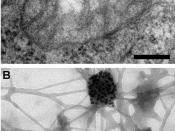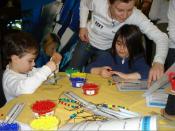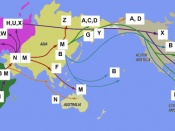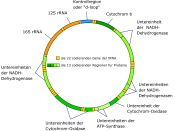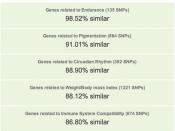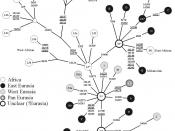In 1987, three scientists unearthed the remnants of the aboriginal human being with mtDNA, a woman they named "Eve" and who is said to be a predecessor of every modernistic human being on earth. All of society can trace their genetics through their mothers to this woman. The scientists arrived at this conclusion by analyzing the cells of living people and mitochondrial DNA (mtDNA).
Mitochondria are tiny structures that produce energy for cells. Each individual one is composed of an identical loop of DNA 16,000 base pairs containing 37 genes. Nuclear DNA consists of 3,000,000,000 base pairs and 70,000 genes.
When an egg cell is fertilized, the nuclear DNA from a sperm cell enter the egg and conjoin with the egg's nuclear DNA. The mtDNA from the sperm cell does not enter the egg cell. This means that the fertilized egg embodies a combination of both the father's and mother's DNA, but only the mother's mtDNA, which means mtDNA is only passed along through the maternal line.
That means that all of the mtDNA in the cells of a body are exact copies of the person's mother. mtDNA is always inherited only from the mother.
"Eve" was not the first human with mtDNA. Other women during her time had mtDNA as well, but it is hypothesized that the females had only sons and the production of mtDNA was halted. Even though everyone living today has inherited the mtDNA from the same person, our mtDNA is not identical. Mutations over the course of the millennia have altered the genetic code. However, these mutations are organized. When there is a mutation, the mtDNA from that point on contains that mutation. Another branch of mtDNA would experience a different mutation, and that branch would contain it from that point on.
By looking at the similarities and differences of the mtDNA of individuals, scientists can only try to reconstruct where the branching took place. Some researchers are doing just that. The three scientists that found "Eve" looked at the mtDNA of 147 people from all over the world. Later they used a computer program to put together a kind of family tree, grouping those with similar DNA together. Then grouped the groups of the groups.
They then estimated the age of "Eve". To do this, they hypothesized that the random mutilations occurred at a steady rate. They estimated the mutation rate by looking at the mtDNA of people whose ancestors migrated to areas at known times.
According to some anthropologists, all "Eve" really is is the woman whose mtDNA did not die out because of lineage extinctions.
BibliographyLeonard, Jonathon Norton Biology .Incorporated: New York, 1967Nicholson, Irene The Study of:DNA. : O.G.A.M, 1967
